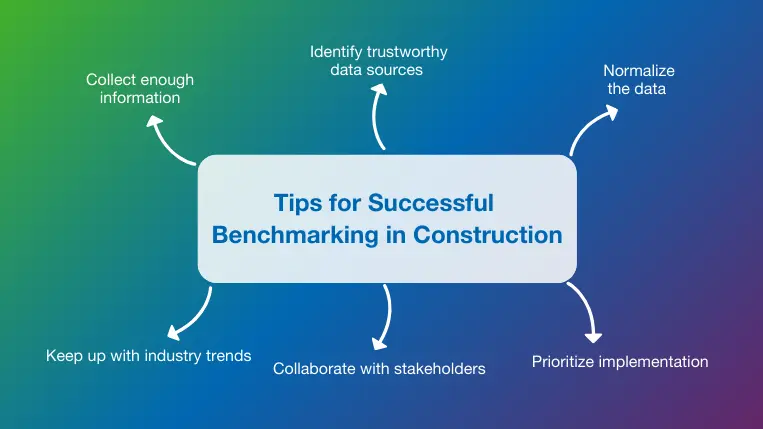11 mins read
Benchmark in Construction: Exploring Key Challenges and Opportunities

Benchmarking is a term we hear in many walks of life, but the word has a different definition for different industries and applications. Construction benchmarking is gaining importance as contractors and project managers leverage available data sources to predict future project costs and timelines.
In this blog post, we examine the definition and common types of construction benchmarks to gain more insight into this important concept. We also review some of the data analysis tools and practices required to overcome common benchmarking challenges.
What is a Benchmark in Construction?
A benchmark is an estimate of expected performance based on the analysis of historical data, cost information, resource allocation, and task times, as well as industry-specific information gathered from outside sources and combined with internal data.
Construction benchmarks allow contractors and other stakeholders to understand trends and gaps that influence cost and on-time delivery, which improves their decision-making and the predictability of future projects. While there are many different types of benchmarking in construction, the process typically follows a continuous loop that includes:
- Defining objectives and the metrics to be collected
- Capturing data and ensuring correct formatting and accuracy
- Compiling and analyzing data using software tools
- Utilizing the insights and analysis to create or update benchmarks
- Repeating the process with new goals and objectives
The specific method chosen to establish benchmarks depends on the availability of new and historical data sources, the type and format of data being collected, the available data collection tools and software, and the time constraints. Common types of construction benchmarks include:
Historical data benchmarks
This type of benchmarking involves the collection and analysis of data from past projects to create reference points for similar efforts in the future. This method is especially valuable when past and future projects are similar in size and scope or utilize the same materials, equipment, and labor resources.
Unit cost benchmarks
As the name implies, the unit cost method is based on predefined amounts of common elements like lumber, concrete, bricks, or labor hours. Granular costs or time allotments are multiplied based on the project scope to create a realistic benchmark. A comprehensive cost database, digital takeoff, and construction estimating software support the accuracy of unit cost benchmarks.
Crew-based benchmarks
Crew-based benchmarks are also based on historical factors but mainly focus on the productivity expectations for crews of various sizes. For example, a crew of five workers might take two weeks to build a foundation, while a crew of eight will finish the work in half the time. Rather than projecting linear results, crew-based benchmarks consider the fit between crew size and task type.
Industry-specific benchmarks
This type of construction benchmark widens the scope of data sources to include published industry standards or data collected from peers and competitors. This method is useful when a company or contractor performs a task for the first time or works in a new location. Industry benchmarks may reveal important conditions that have impacted scheduling and pricing for others in the past.
What Is the Purpose of Construction Benchmarks?
Construction benchmarking serves an important purpose by establishing standards and performance metrics that allow project teams to monitor their productivity, cost-efficiency, and other factors based on expected values and then learn from the process when the benchmarks do not align with reality.
Benchmarking is also an important part of planning and risk management in construction projects since accurate, data-driven values help to set realistic goals and timelines while identifying inefficiencies or gaps that can put the financial success of a project at risk. Construction cost benchmarking uses data to take the guesswork out of important calculations and projections.
Benchmarks are closely tied to the construction cost estimation process since they provide a foundation based on historical data that allows estimates to be evaluated fairly. Comparing estimates with benchmarked standards is a good way to identify discrepancies, errors, and gaps while ensuring budgets are accurate and reliable.
Common Challenges in Construction Benchmarking
Benchmarking has been an essential part of doing business in the manufacturing industry for over 100 years. Production cycle times, materials costs, and seasonal variation are tracked closely to predict delivery dates with pinpoint accuracy. In the building industry, this hasn’t always been the case.
The most persistent challenge for benchmarking in construction has been the lack of data. Benchmarks become more accurate as more relevant information is made available, but the uniqueness of projects, lack of historical records, and confidentiality concerns between contractors can make the right data hard to find. Benchmarks based on inadequate information can be dangerous since they may lead to flawed conclusions or unrealistic expectations. Additional challenges for benchmarking include:
- Inconsistent data collection methods between projects and teams
- Fluctuating labor, material, and equipment costs
- Variability in construction crew skill and competency
- Schedule pressure taking precedence over data collection
- Deciding on the key performance indicators (KPIs) to benchmark
Software technology helps to alleviate many of these challenges, but building companies and contractors have been slow to adopt digital construction technologies that simplify resources, material, and equipment monitoring in the field. These tools can provide a ready-made data pool to support the benchmarking process.
Tips for Successful Benchmarking in Construction

Construction benchmarking is a valuable practice, but it is not always easy to implement successfully. Common sense practices help to ensure the time and effort required to establish benchmarks add value to future projects.
1. Collect enough information
Having enough data for meaningful analysis is important for any type of benchmarking. This is especially relevant in the building industry, where the wide variety of projects, tasks, and requirements can lead to more outliers and bias. A larger sampling of data makes it easier to separate meaningful results and trends from metrics that only pertain to a specific type of project.
2. Identify trustworthy data sources
While more data is usually better, the quality of the data also counts. For example, if material costs from ten years ago are combined with current figures, the results will not reflect the present conditions. A trustworthy data source must also be complete and collected in a repeatable way, using the same tools and processes for every project.
3. Normalize the data
Data normalization is another important element of construction cost benchmarking since it allows information from different types of construction projects, tasks, or geographies to be pooled together successfully without skewing the results. The data normalization process uses statistical methods to account for differences by adapting or “normalizing” the raw data. Normalization allows more diverse data sources to be utilized to support benchmarking.
4. Prioritize implementation
Benchmarking does not need to be an all-or-nothing proposition. A phased approach can help contractors learn how benchmarks are used in construction as they target the most important areas first. Collecting data for a single metric, such as framing time per square foot of floor space, allows contractors and workers to streamline the data collection process, identify roadblocks, and evaluate software tools thoroughly before moving on to other benchmarks.
5. Collaborate with stakeholders
Collaboration is a key element of construction benchmarking since it ensures owners, contractors, and other construction roles are involved in the process, aligned on data collection practices, and fully understands the purpose and importance of benchmarking. This deeper understanding helps to prevent errors or misunderstandings that can corrupt the data set. A commitment to collaboration also allows more stakeholders to have a say in choosing useful metrics to benchmark.
6. Keep up with industry trends
Each company will develop its own benchmarking and analysis preferences, but remaining consistent with industry norms and standards is also important. When different companies benchmark the same metrics using similar criteria and methods, it makes it easier to compare their results or pool data between multiple organizations and contractors to improve the statistical power of the data set.
Conclusion
The word benchmark implies a value or standard that serves as a fixed measure of success or failure, but taking a more flexible approach to the benchmarking process is the best way to maximize value. That said, benchmarking can be difficult without the right digital tools to reliably collect project data, calculate standards, and report results.
Professional estimating software, like RIB CostX, can help gather valuable historical data and use it for benchmarking, allowing companies to compare projected costs with benchmarks to identify inefficiencies and improve. Using estimating solutions for benchmarking also helps improve the accuracy of estimates by using historical data from similar projects, decreasing the risk of mistakes due to miscalculations.
If you are ready to experience the power of modern estimating technology to improve your performance, get your free demo for RIB CostX today!

Most Recent
11 mins read
10 mins read
10 mins read
29 mins read
Blog Categories

Ebook











